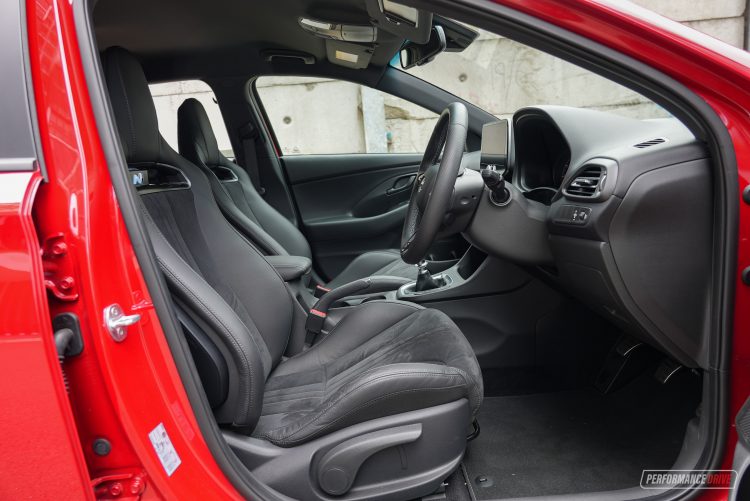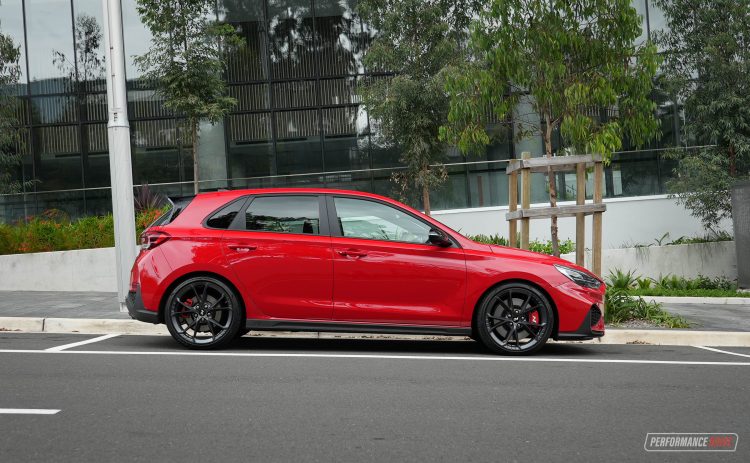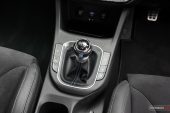Hyundai has been on a roll in the past few years bringing out cracking vehicles, and today’s subject, the 2022 i30 N, has been hugely influential in showcasing the world that Hyundai can impress when it comes to performance motoring, too.
In its latest form, Hyundai has given the i30 N even more power, upgraded the suspension hardware and given the hatch a mild styling refresh with some added equipment to boot.
These upgrades haven’t come without a premium, though, with prices for the i30 N rising by $3500 to $44,500 for the entry-level variant with a manual gearbox. The good news, however, is that the i30 N remains significantly cheaper than its spiritual inspiration, the Golf GTI and the Honda Civic Type R.
Adding a new eight-speed wet dual-clutch transmission (DCT review here) brings the price to $47,500, while the N Premium with a manual box is priced from $49,000. Stepping up to the i30 N Premium adds a set of heated bucket seats with leather and Alcantara upholstery, a heated steering wheel, and front-mounted parking sensors, while the optional sunroof brings prices for the manual and DCT to $49,000 and $52,000, respectively.
With all that in mind, just how good is the Hyundai i30 N, and is the base model the pick of the bunch or are you better off spending a little extra for the N Premium? Let’s find out.
2022 Hyundai i30 N manual – THE SPECS
[column width=”47%” padding=”6%”]Engine: 2.0-litre turbo four-cylinder
Output: 206kW@6000rpm / 392Nm@2100-4700rpm
Transmission: Six-speed manual
Drive type: Front-wheel drive, LSD
Wheels: F & R: 19×8.0, 235/35
ANCAP: Not tested (regular i30 5 stars)
Tare weight: 1478kg
Power-to-weight: 7.17:1 (kg:kW)
Official fuel economy: 8.5L/100km
Economy during test: 10L/100km
Fuel capacity/Type: 50L/95 RON[/column] [column width=”47%” padding=”0″]Power efficiency: 24.23kW:L/100km
0-60km/h: 3.32 seconds*
0-100km/h: 6.09 seconds*
60-110km/h: 3.66 seconds*
1/4 mile: 14.04 seconds at 165.8km/h*
Max acceleration: 0.774g
100-0km/h braking: 2.99 seconds at 37.79 metres*
Max deceleration: -1.261g
Decibel at idle (/N mode): 46/50*
Peak decibel at 60-100km/h: 87/90*
Priced from: $45,000[/column][end_columns]
* Figures as tested by PerformanceDrive on the day. Factory claims may be different
2022 Hyundai i30 N manual – THE PACKAGE
The entry-level i30 N rides on a set of 19-inch forged alloy wheels wrapped in Pirelli P Zero tyres, with adaptive suspension, an upgraded 360mm set of brakes, variable exhaust system, LED head and taillights, dual-zone climate control, keyless entry and start, cloth upholstery, rear-view camera and a heap of safety equipment.
It cuts a meaty little silhouette on the street, with the low stature, updated fascia and imposing forged alloys suggesting this isn’t your average i30. Other than that, and the N-specific aero kit and some subtle design details, the i30 N’s styling doesn’t necessarily shout about its performance. We think it strikes a wonderful profile on the road, showing rather than shouting at passers-by.
Inside, there’s not too much to get the heart racing, with a completely familiar cockpit devoid of many special touches, suggesting Hyundai might be holding off on some interior details to get people to move higher up into the range. Having said that, though, you’ll be quick to notice the chunky, specialist steering wheel with its chequered flag pattern, drive mode buttons and blue contrast stitching.
The door surrounds and central tunnel displays a fairly cheap plastic design, but practicality is high thanks to cup holders and lots of storage. Underwhelming cloth-lined seats don’t look all that appealing but big side bolstering hugs you tight in the curves. The seats are manually-adjustable, but remain surprisingly comfortable on longer trips.
In terms of practicality, the i30 N doesn’t make any major sacrifices, with the exception of the anti-roll bar in the boot. That means up front the driver and front passenger have a decent amount of head and shoulder room, complemented by a great driving position.
The cockpit is restrained and clean, with a narrow 10.25-inch infotainment touch-screen stretching its way atop the dash, with a straightforward selection of buttons for the climate settings and some charging ports in the storage space that doubles as a wireless charger. The infotainment unit itself has a crisp high-definition resolution with no latency between inputs, and is a quality, user-friendly system to use.
Moving to the second row, with the driver’s position set for a 180cm adult, there’s enough room for an adult behind, albeit with their legs pushing slightly against the seatback. But overall, the platform is perfectly suited to those looking for a fast second car that can still stand up to family duties.
On the topic of family duties, the i30 N features a pair of ISOFIX anchors on the outboard seats, with top tether mounts for rear-facing child seats.
In terms of boot space, the i30 N hatch offers up 381L of cargo storage in the boot, which expands to 1287L with the rear seats folded down. However, that roll-bar gets in the way of smoothly loading in long objects.
2022 Hyundai i30 N manual – THE DRIVE
Hyundai has updated the latest i30 N with an Australian-spec suspension tune, tweaks to the variable exhaust system, upgraded brake discs and an additional 4kW/39Nm squeezed out of the powertrain from a new turbocharger and intercooler. That means the 2.0-litre turbo four-pot now throws 206kW/392Nm of pure punishment to the front wheels via a six-speed manual and limited-slip differential.
You can sum up the driving experience with just a few words: it’s fast, fun and loud. We can only take our hat off to Hyundai for making front-wheel drive this much fun. Stepping on the throttle prompts the engine into action, and while the turbo takes a little bit of time to spool up, the performance is immense. We clocked a best 0-100km/h time of 6.09 seconds, which is proper fast for a manual front-drive car.
When exiting a high-speed corner, the ‘N Corner Carving’ differential kicks into life. You can feel it shuffling power between the front wheels for optimum traction and speed. It is a heap of fun to play around with, and makes the car feel like it’s riding on a loose set of rails, effectively eliminating understeer.
The suspension geometry has increased negative camber on the front wheels, also helping to reduce understeer over the predecessor. Perhaps the best part, though, or at least the single-most addictive feature we found is that variable exhaust. It produces a range of snaps, crackles, pops and bangs that you can’t help but be intoxicated by.
That, and the manual gearbox are the answer to a lot of motoring enthusiasts’ prayers. So in that regard, we’ll tip our hat once again to the engineers at Hyundai.
In terms of daily driving, the i30 N is a great option so long as you live in and around a town or city with nice, smooth roads. When its time to calm down, simply slip into normal or eco mode and the suspension softens up – a little bit – while the exhaust goes back into a more civilised and less explosive setting.
Hyundai allows you to customise your drive settings, including two completely configurable N driving modes with your preference for the dampeners, steering, throttle, differential, rev-matching and exhaust.
Around town, you’ll be scraping the nose protector on steep inclined driveways or carpark entrances, but that’s all part of the hot hatch experience and most rivals are similar. The same goes for the turning circle. It can seem a little cumbersome and wide, making it more tricky to pilot around town than a regular hatchback.
Other than those small gripes, though, the i30 N is an awesome little companion to drive around town, offering a huge wave of torque and a crackling exhaust to accompany you on your way to work.
During our week with this test car, the engine consumed an average of 10L/100km. That’s well above the 8.5L/100km official figure, but we’r sure you could see lower figures than our average over a longer period.
To sum up, the i30 N makes driving fun. Better still, it takes the user-friendly nature that hot-hatches are famous for and adds a generous handful of hooliganism to the mix, reminiscent of the original design brief for the hot hatch.
2022 Hyundai i30 N manual – THE VIDEO
2022 Hyundai i30 N manual – THE VERDICT
For the price, we can’t think of a single better option when it comes to a fun-loving hatch that also meets most of your family duties, too. It might not be as pinpoint accurate as the Toyota GR Yaris, however, the i30 N has a far-livelier personality, and you’re saving some serious cash at the showroom.
In terms of the question we posed at the start, is this the variant to go for? We’d say absolutely yes, unless you’re really set on the added garnishes of the Premium variant.
[column width=”47%” padding=”6%”]PROS:
– Intoxicating exhaust noise
– Impressive front differential makes FWD seriously fun
– Monstrous performance for the money
– Practical cabin for family duties
[/column] [column width=”47%” padding=”0″]CONS:
– Blandish interior in base model
– Stiff ride on rough country B-roads
– Large turning circle around town[/column][end_columns]
As always, if you’re thinking about buying a new car don’t forget to click here to speak with our car buying specialists.
























